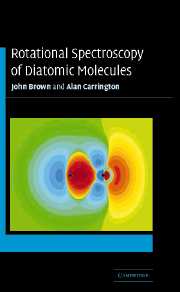Book contents
- Frontmatter
- Contents
- Preface
- Summary of notation
- Figure acknowledgements
- 1 General introduction
- 2 The separation of nuclear and electronic motion
- 3 The electronic Hamiltonian
- 4 Interactions arising from nuclear magnetic and electric moments
- 5 Angular momentum theory and spherical tensor algebra
- 6 Electronic and vibrational states
- 7 Derivation of the effective Hamiltonian
- 8 Molecular beam magnetic and electric resonance
- 9 Microwave and far-infrared magnetic resonance
- 10 Pure rotational spectroscopy
- 11 Double resonance spectroscopy
- General appendices
- Author index
- Subject index
- References
11 - Double resonance spectroscopy
Published online by Cambridge University Press: 17 December 2010
- Frontmatter
- Contents
- Preface
- Summary of notation
- Figure acknowledgements
- 1 General introduction
- 2 The separation of nuclear and electronic motion
- 3 The electronic Hamiltonian
- 4 Interactions arising from nuclear magnetic and electric moments
- 5 Angular momentum theory and spherical tensor algebra
- 6 Electronic and vibrational states
- 7 Derivation of the effective Hamiltonian
- 8 Molecular beam magnetic and electric resonance
- 9 Microwave and far-infrared magnetic resonance
- 10 Pure rotational spectroscopy
- 11 Double resonance spectroscopy
- General appendices
- Author index
- Subject index
- References
Summary
Introduction
Double resonance spectroscopy involves the simultaneous use of two spectroscopic radiation sources, often of quite different wavelengths. Figure (a) illustrates the simplest example of many possible variations. High-frequency electronic excitation (f1) is combined with microwave or radiofrequency radiation (f2); the objective is usually to observe and measure the lower frequency spectrum by making use of the sensitivity advantages provided by the higher frequency radiation. Detection of the fluorescence intensity from the intermediate state E2 provides a monitor of the population of the state. The lower frequency transition f2 changes the population of E2, and hence changes the fluorescence intensity. Many of the experiments to be described in this chapter depend upon this simple scheme. Such experiments have been extremely valuable, particularly in the study of short-lived species such as neutral free radicals, molecular ions, or metastable excited electronic states. Their success usually depends on prior knowledge and study of the high-frequency spectrum, as we shall see. In other cases, however, the two radiation sources may be of similar wavelengths; microwave/microwave double resonance, for example, has proved to be a powerful method for confirming otherwise uncertain spectroscopic assignments.
As is often the case, the initial experiments were developed by atomic spectroscopists. Figure (b) illustrates an example from atomic physics, described by Brossel and Bitter. Mercury atoms are excited by a mercury lamp from the 1S ground state to the 3P1 excited state, in the presence of a small applied magnetic field.
- Type
- Chapter
- Information
- Rotational Spectroscopy of Diatomic Molecules , pp. 870 - 977Publisher: Cambridge University PressPrint publication year: 2003

